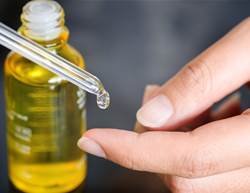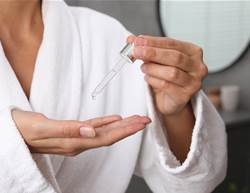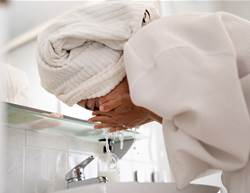Red light therapy is the latest buzzy skincare treatment touted on social media for its anti-aging properties. And with celebrities like Kate Hudson, Victoria Beckham, and Chrissy Teigen posting pictures donning glowing, light-emitting face masks or waving red wands over their faces, red light therapy benefits must be worth the hype, right? But what is red light therapy, exactly, and how does it work?
According to dermatologist Dr Jodi LoGerfo, red light therapy (RLT) involves using light-light emitting diode (LED) devices that “produce varying wavelengths of light that treat a variety of skin issues, including acne, psoriasis, fine lines and wrinkles.”
Also known as low-level laser light therapy (LLLT), low-power laser therapy (LPLT), or photobiomodulation (PBM), this non-invasive treatment has become an increasingly popular option for its touted skin health benefits.
If you’re wondering if you should incorporate red light therapy into your skincare routine, here’s what dermatologists say you should know, including the low-down on its touted benefits, safety, and risks, and whether at-home treatments are truly worth the money.
What is red light therapy?
Red light therapy usually takes the form of a face mask, light panel, or wand equipped with LED lights, which you place near your skin to let your cells “absorb” the light.
“Red light therapy is theorised to work on the mitochondria of our cells: the engine,” explains Dr LoGerfo. “This gives the cells of the body more energy, allowing other cells to function with maximum productivity. For the skin, this includes skin restoration and repair which can help increase new cell growth and intensify the restoration process.”
Red light therapy benefits
Red light therapy benefits may include the following, according to experts:
- Reduce the appearance of wrinkles. It benefits elastin and collagen in the skin, causing the skin to feel smoother, more toned, and also appear less wrinkled, says plastic surgeon Dr Anthony Youn.
- Increase circulation
- Decrease inflammation
- Address acne. DrLoGerfo says red light therapy may help treat acne. “They also can decrease redness and help acne marks to fade faster,” says dermatologist Dr Diane Madfes.
- Help with hyperpigmentation and psoriasis.
- May help with hair loss. Dr LoGerfo says that red light therapy may increase hair growth and density.
LED light therapy isn’t just limited to red light, either; various wavelengths can have varying effects on your body, explains Dr Madfes. “Blue light is anti-microbial, red light decreases inflammation and induces collagen remodelling, orange/amber, and green light [is good] for soothing and calming,” she notes.
Red light therapy side effects and safety
Red light therapy is considered to be completely safe, as long as you make sure to wear eye protection goggles. “Damage to the eyes can occur from long-term blue or red-light exposure,” warns Dr LoGerfo.
Side effects from red light therapy are minimal, and if there are any, they’re usually mild. But there are certain conditions in which it might be best to avoid the treatment. Specifically, anti-aging expert Dr Neil Paulvin doesn’t recommend it if you have seizures or eye disorders.
“Flicker (changes of frequency of light) at a high rate can lead to headaches, dizziness, and possible seizures at worst,” he notes.
Similarly, Dr Madfes doesn’t recommend red light therapy for anyone with photosensitizing medical conditions, such as lupus, or anyone taking a photo-sensitising medication. You should also avoid it if you have any open wounds or lesions on your skin.
Does red light therapy work?
There is an emerging body of research that shows the potential of red light therapy to help improve skin health and treat certain skin conditions, including a small 2014 study that showed that light therapy led to improved skin complexion and feeling, reduction of skin roughness and wrinkles, and increased collagen density. However, more extensive research needs to be done.
“Although there are some studies regarding their benefit, they are not abundant, and we are not entirely sure how they work,” says Dr LoGerfo.
Dr Paulvin says that it may take consistency and time to notice results with red light therapy. Even then, Dr LoGerfo says that you should have realistic expectations. “People should know that results you usually see with these treatments are mild,” she says. “They aren’t a game changer when it comes to fine lines, wrinkles, hair loss, etc.”
Still, red light therapy definitely shows promise in the field of dermatology, especially due to its safe, non-invasive nature and its minimal side effects.
Can I use red light therapy at home?
If you want to head to a specialist and receive red light therapy, in-office treatments are available. “Some offices have full red light beds that you can lie down in and treat your whole body, not just your face and neck,” says Dr Youn.
If you prefer to forego a doctor’s visit, now there are LED red light masks and handheld devices you can purchase and use at home. Keep in mind, though, that “the masks that are for at-home use are less powerful than the ones available at a dermatologist’s office,” says Dr LoGerfo, which means you may not see the kind of results you might get from an in-office treatment.
If you are looking to purchase a red light therapy device to use at home, Dr LoGerfo recommends looking for ones that are from a reliable company. A personal favourite of Dr Madfes is the Priori Skincare UNVEILED Face LED Mask, which she says is not only backed by science for efficacy, but is portable, rechargeable, and comfortable to wear.
The CurrentBody Skin LED Light Therapy Face Mask is another leading at-home option. It was one of the 2023 Prevention Beauty Award winners, with judges saying it boosted skin-cell renewal.
When undergoing red light therapy, Dr Madfes advises cleansing your face before using, and always applying an antioxidant serum immediately after your session.
How often should you get red light therapy?
“Typically, the LED face masks are left on the skin for 20 to 30 minutes. The treatment can be done two or three times a week,” says Dr LoGerfo. “If you are using a handheld device, it can be used three to five times a week for 10-20 minutes each time.”
Dr Paulvin himself recommends undergoing red light therapy four to five times per week, ideally, as it takes consistency to get more noticeable results. “There is no maximum or limit to exposure,” he adds.
The number of treatments you need may vary depending on the specific red light therapy device you’re using. If you’re using an at-home device, you should always be sure to read and follow the manufacturer’s instructions carefully.
The bottom line
Red light therapy is a promising and emerging treatment option for rejuvenating skin and treating conditions such as acne, psoriasis, hyperpigmentation, and even hair loss. It’s generally considered to be safe with minimal side effects, and can also be safely practiced at home, in addition to standard in-office treatments. However, if you have severe acne, skin disease, or hair loss, you should always consult a healthcare professional, says Dr LoGerfo.









